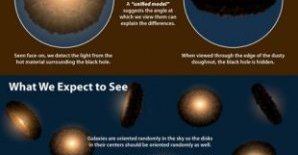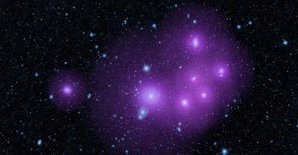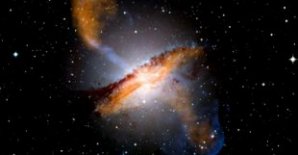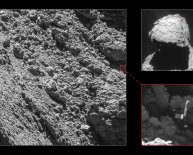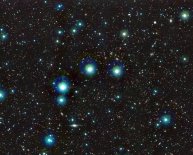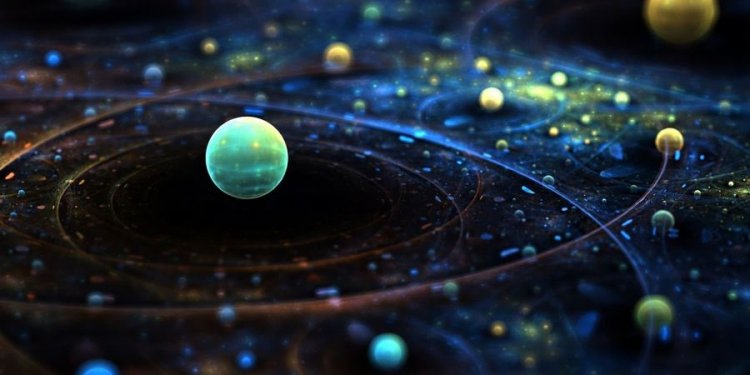
Outer space Galaxies
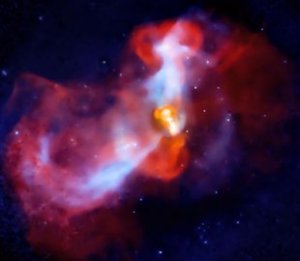
Active Galaxy Overview
An active galaxy is a galaxy that has a very small core of extremely high powered emissions emanating from the center of the galaxy. The core is very bright and may be highly variable compared to the rest of the galaxy. Some active galaxies have jets emanating from two sides of the center. It is believed that almost all galaxies have super-massive black holes at their centers. "Active" galaxies have an Active Galactic Nucleus (AGN) and are often referred to as "AGN" galaxies. But, not all galaxies have an "active" super-massive black hole.
For example, the black hole in our Milky Way Galaxy is not active. To be active, the galaxy must have a source of gas, dust, and/or other debris that the super-massive black hole can readily consume. As a galaxy ages, its black hole eventually runs out of local consumable materials and the black hole becomes "dormant" (but not dead).
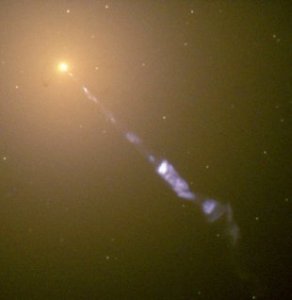 If a fresh supply of material is devoured, a dormant super-massive black hole can begin to emit high powered jets again. This happens from time to time when two galaxies collide, or a star or nebula (cloud of gas) gets pulled into the gravity domain of a super-massive black hole. There is an accretion disk around the black hole which accelerates the materials to close to light speed and some
If a fresh supply of material is devoured, a dormant super-massive black hole can begin to emit high powered jets again. This happens from time to time when two galaxies collide, or a star or nebula (cloud of gas) gets pulled into the gravity domain of a super-massive black hole. There is an accretion disk around the black hole which accelerates the materials to close to light speed and some
of the material is ejected out of the disk in the form of jets.
Pictured to the left above is Messier 87 (M87 for short or NGC 4486) a very active "radio" galaxy in the Virgo Cluster. The small white round circle in the center is the super-massive black hole. This image is a composite from NASA's Chandra X-ray Observatory (x-rays in blue) and the National Science Foundation's Very Large Array (VLA) radio observations in red. In this image, cold gas matter from the cluster is falling towards the core of M87, where it's met by the near light speed jet, producing shock waves in the galaxy's nearby interstellar medium.
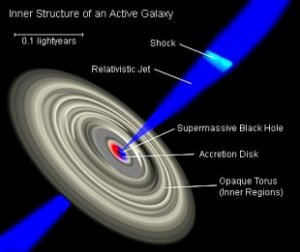 Also to the left, is a normal light view of M87 from the Hubble Space Telescope. The super long jet is 5, 000 light years in length! The yellow ball is the AGN center, whereas the long blue jet is synchrotron radiation. Synchrotron radiation originates from collisions of electrons and positrons circulating at extremely high speeds around the lines of a strong, twisting and growing magnetic field.
Also to the left, is a normal light view of M87 from the Hubble Space Telescope. The super long jet is 5, 000 light years in length! The yellow ball is the AGN center, whereas the long blue jet is synchrotron radiation. Synchrotron radiation originates from collisions of electrons and positrons circulating at extremely high speeds around the lines of a strong, twisting and growing magnetic field.
All AGN galaxies exhibit the same basic processes. Namely, a super-massive "active" black hole at the center and an accretion disk around the black hole. They all have a bright central core fed by local gas and/or a nearby star. They differ mainly in intensity of input. The more intense the galactic center, the higher the radiation energy it emits. The radiation emitted varies from radio and infrared waves to x-rays and gamma-rays.
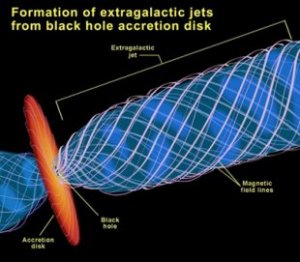 Before we dive into the various sub-categories of AGNs, let us take a look at the basic structure of active galaxies.
Before we dive into the various sub-categories of AGNs, let us take a look at the basic structure of active galaxies.
Basics Of An Active Galaxy
While it is still not fully understood "exactly" how jets are formed, most astro-physicists believe the jet's power comes from the accretion disc. Accretion discs around some other stellar objects are able to produce jets, but the jets around black holes are by far the most active and approach the speed of light. This is because the speed of the jet is about the same speed as the escape velocity from the accretion disk. This makes the speed of a jet from a black hole disk near the speed of light, while jets from newly born stars are much slower. When matter is ejected at speeds approaching the speed of light, these jets are called "relativistic" jets.
The most popular jet formation hypothesis is that the twisting of magnetic fields in the accretion disk collimates the outflow of plasma along the rotating axis of the black hole so that jets emerge from each face of the disk. See the artist's conception at the left.

